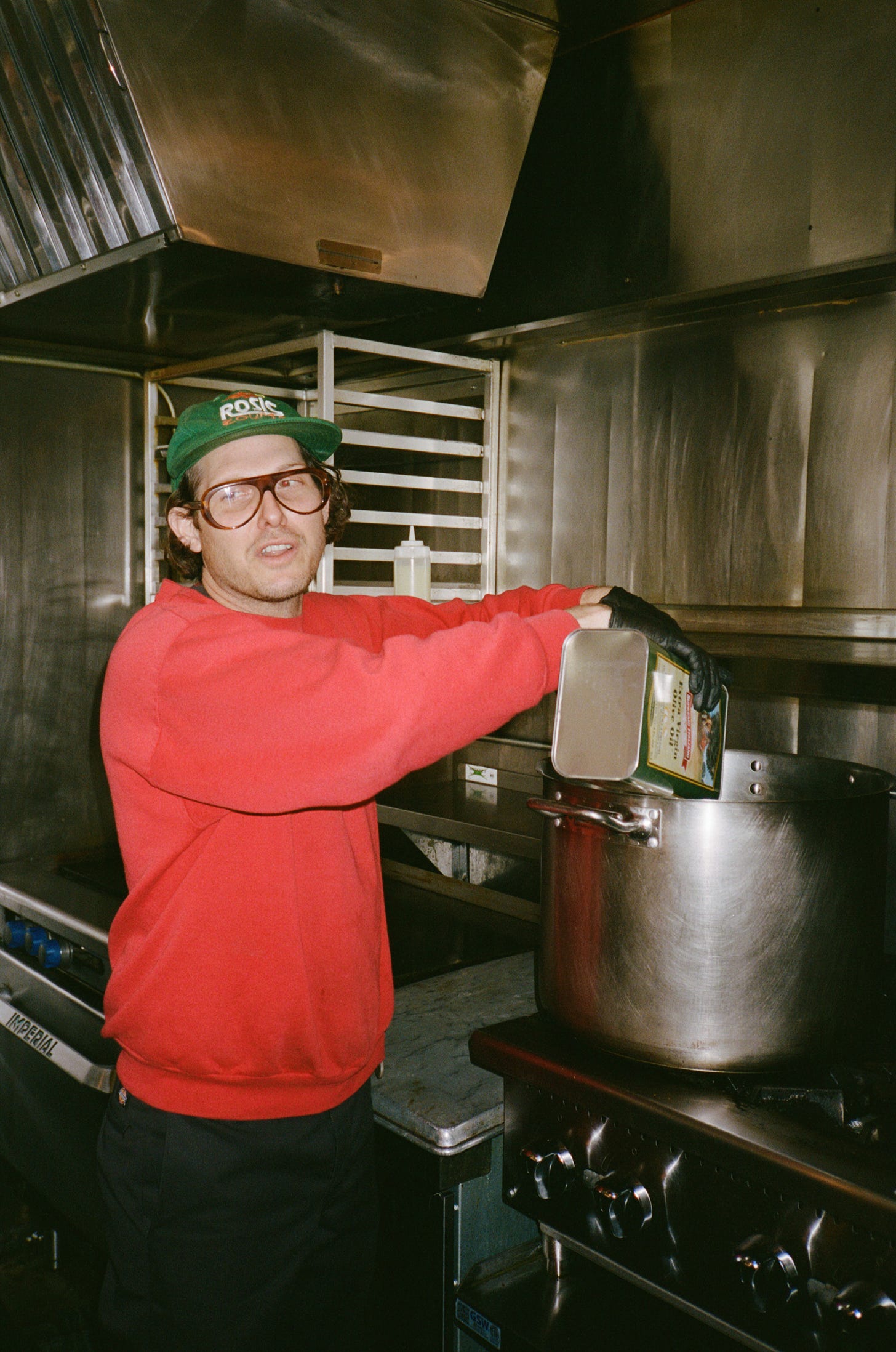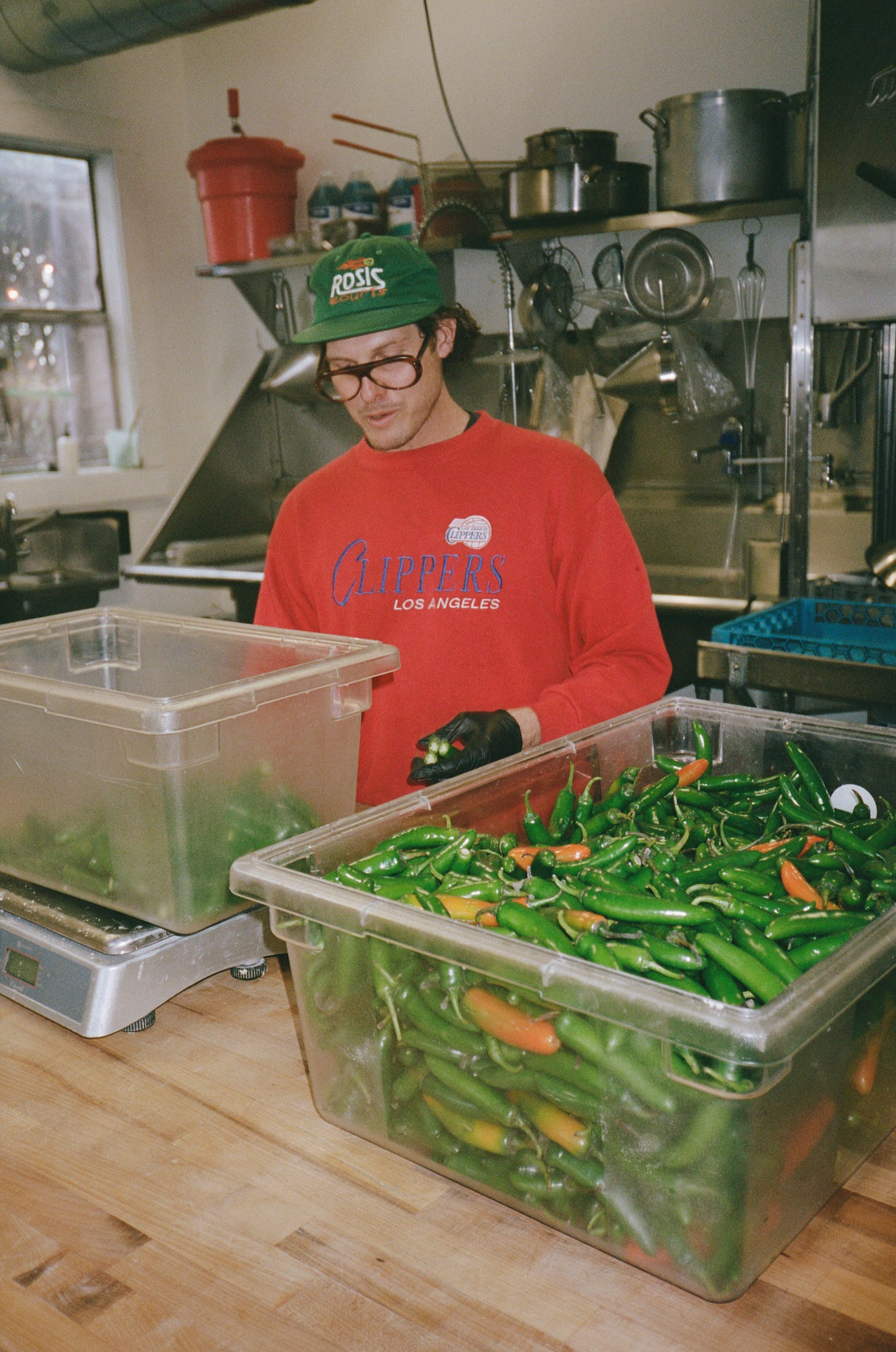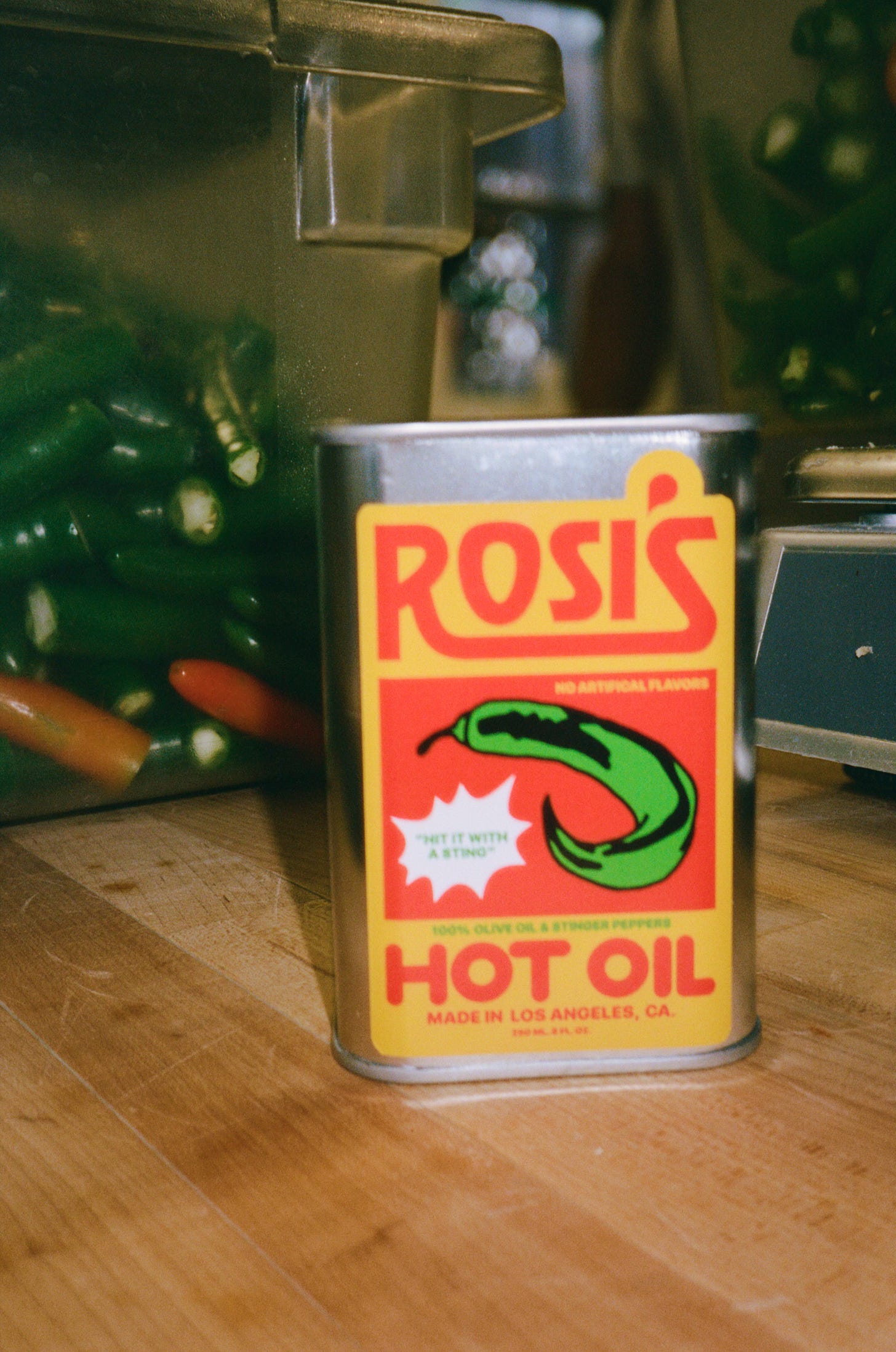Rosi’s Hot Oil Will Be to Pizza as Sriracha is to Pho
Chris Rosi has big ambitions for his serrano-spiked oil inspired by Connecticut and made in Los Angeles.
Photographs by Emily Wilson
Every Sunday evening, Chris Rosi makes a fresh vat of hot oil. He glugs liters upon liters of extra-virgin olive oil into a big steel pot, sets it over a low temperature, then starts chopping the stems off serrano peppers, hacking a handful at a time from a seemingly never-ending tub of chiles uniform in shape and forest green color. By the time he’s finished prepping half the peppers, the oil has reached 200 degrees Fahrenheit, and the confit process can commence. While the first batch fries, he trims the remaining serranos, then adds them to the oil for an extra layer of heat and depth. “If I really buckle down, I can do it in three hours,” Rosi says, from the kitchen of Café Tropical, where he makes his eponymous hot oil during off-hours. He’s about an hour into his weekly production, and a sharp, earthy smell is beginning to perfume the air around us. I can feel a burn in my nostrils, the welling of my eyes.
Rosi’s Hot Oil is the name of the product. It’s zesty with a smoky undercurrent, shimmery green-gold in hue, not too spicy, good on eggs and clams, and excellent on pizza—which is exactly the point. “I want to be in every pizzeria, on the counter next to the grated cheese,” says Rosi. “My dream is for [Rosi’s] to be like sriracha in Vietnamese restaurants.”
Although crushed red pepper flakes reign supreme as the heat-supplying condiment in any given pizzeria, chili oil has become increasingly common, particularly in sit-down joints. The first time I recall having it on pizza was about eight years ago at Ops in Brooklyn, where the exceptional sourdough pies are served alongside chopped red chiles in oil. At F&F Pizzeria, also in Brooklyn, the owners’ brand of chili oil, spiked with fruity, fiery red Calabrian chiles, is available to drizzle on top of your slice. Tony Geminagi, out of San Francisco, makes a Calabrian hot pepper oil, too. The most well-known product on the relatively untapped pizza oil market is Brightland’s pizza oil, which is made with cayenne pepper extract, jalapeño extract, and oregano oil, amongst other ingredients. Unlike Rosi’s, however, Brightland markets its pizza oil to an at-home cooking audience. “Whereas we’re more in the trenches of the pizzeria,” says Rosi.
The idea for Rosi’s Hot Oil began at one pizzeria and was inspired by another. Rosi grew up Italian-American in Stamford, Connecticut, where he was privileged with an education in pizza from a young age. He ate at Frank Pepe’s in New Haven with his travel hockey team, at Pappas Pizza (which serves the rare, regional Greek-style pizza), at the hole-in-the-wall Belltown Pizzeria, and, most frequently, at Colony Grill, a 90-year-old tavern-style pizzeria known for its ultra-thin-crust bar pies and signature hot oil. At the beginning of 2023, he started working in the kitchen at Quarter Sheets, which is celebrated for its Detroit-leaning pan pies. A few months into his time there, Rosi learned that bar pies were on chef-owner Aaron Lindell’s radar. The two of them started riffing on dough recipes. “I was like, ‘This place I grew up going to, they put this hot oil on the pizza. I don’t really know what it was, but it was some kind of chili oil.’ I found out that it was serranos fried in oil. So we [made it], and it turned out spot-on,” he says. When the bar pies debuted on the menu—now available on Wednesdays and Sundays—the hot oil debuted, too. “Guests really liked it, and started to ask for sides of it,” Rosi says.
He felt like they had something meaningful on their hands. So he pitched Lindell and co-owner and pastry chef Hannah Ziskin on canning the oil and bringing on his long-time friends, Taylor Johnson and Dusty Peterman of the San Diego-based Mortis Studio, to design a brand. “They were like, ‘You should just do it on your own,’” he says. One of Rosi’s first moves was to partner with Café Tropical’s Ed Cornell, whom he worked with at Quarter Sheets, and who founded the Washington, D.C.-based novelty ice cream brand Milk Cult.
Rosi’s career has been a mash-up of playing music and working in the culinary world. He met his wife in San Diego, where he worked at the New York-style Pizzeria Luigi. “I was in a band at the time, and everyone there was in bands and were skateboarders. It was kind of a punk place. I got some chops there as a pizza-maker,” he says. Then the two of them moved to New York, and he got a job at the then-nascent Van Leeuwen Ice Cream, which only had one store and a few trucks. After a brief stint in Austin and a return to San Diego (and Pizzeria Luigi), he reached back out to Van Leeuwen when he heard they were expanding to L.A. Rosi ended up working in ice cream for seven years, rising the ranks to become a Los Angeles area manager for the brand. Right before COVID hit, he quit to focus on music, and when music wasn’t happening anymore, he ended up back in pizza, this time at Quarter Sheets. “I’m not really like a chef chef, I don’t have chef’s skills or knife skills, I never went to culinary school. But I do know pizza,” he says.
At present, Rosi’s Hot Oil is a side hustle with hopes to morph into something significant. Rosi still spends most of his professional time working at Quarter Sheets, which has since transitioned to using a different pepper in their hot oil, to have some separation from Rosi’s serranos. But the product’s traction is mounting: you can find Rosi’s Hot Oil on the counter at Silver Lake’s Hot Tongue Pizza, utilized (and on sale) at Companion in Venice, and, perhaps most notably, as the spicy condiment of choice at Chrissy’s, a sensational slice shop in New York. It’s also sold at Brooklyn’s Big Night, a golden child amongst nationwide shoppy shops.
Growth thus far has been entirely organic. “There was a period of time when I bopped around L.A. [pitching stores]. We were in Ferrazzani’s for a second, but I never did a restock there. I tried to get into Cookbook, but they didn’t want it at the time,” says Rosi. Last December, a viral video by the comedian Esther Povitsky spiked sales, and since then, most of Rosi’s business has been direct-to-consumer online. But a research and networking trip to New York last summer proved to be a turning point. Through mutual friends, Rosi and Cornell were connected with Chris Hansell of Chrissy’s, and they swiftly hit it off. “He’s a band guy, I’m a band guy. I think we have the same aesthetic,” says Rosi. Chrissy’s endorsement is what led Big Night to reach out. Last month, Rosi’s popped up at Chrissy’s, and in June, they’ll be back in New York, this time at the next-gen slice shop Lucia, in Soho.
For a brand that wants to be in every pizzeria, being on the ground in New York, where pizza is the food equivalent of water, is more impactful than here in L.A. Still, Rosi’s is ultimately a love child of Connecticut and Los Angeles. “An homage to my hometown flavor,” as Rosi puts it, made in a city where “there’s a thriving pizza community that’s blossoming in real time.” As his quest for pizzeria domination unfolds, Rosi plans to keep marketing his oil as he would a band, with hopes to embark on a pizza tour of America. In the meantime, he’s slowly chipping away at his ambition, which is even bigger than landing in every pizzeria in the world. “The expectations of pizza are not high,” he says. “Part of our strategy is that we can make any pizza better.”







Gotta get my hands on some of Rosi’s Hot Oil